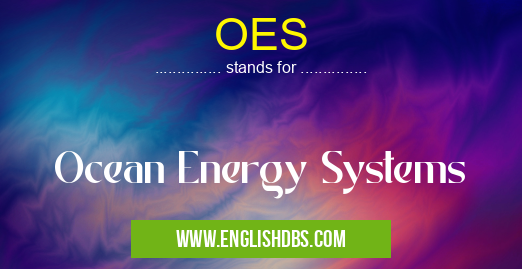What does OES mean in OCEAN SCIENCE
OES stands for Ocean Energy Systems. It refers to the field of science and engineering that focuses on harnessing the energy from the ocean to generate electricity. OES encompasses a wide range of technologies designed to convert various forms of ocean energy, such as waves, tides, currents, and thermal gradients, into usable electricity.

OES meaning in Ocean Science in Academic & Science
OES mostly used in an acronym Ocean Science in Category Academic & Science that means Ocean Energy Systems
Shorthand: OES,
Full Form: Ocean Energy Systems
For more information of "Ocean Energy Systems", see the section below.
What does OES Stand for?
OES is an acronym that stands for:
- O: Ocean
- E: Energy
- S: Systems
Applications of OES
- Wave Energy: OES can utilize the kinetic energy of ocean waves to generate electricity. Wave energy converters convert the up-and-down motion of waves into rotational energy, which is then used to turn a generator.
- Tidal Energy: OES systems can harness the energy from the tides, which is caused by the gravitational pull of the moon and sun on the Earth's oceans. Tidal turbines are designed to capture the kinetic energy of moving water during high and low tides.
- Current Energy: OES systems can generate electricity from ocean currents. These underwater turbines convert the kinetic energy of flowing water into rotational energy.
- Thermal Gradient Energy: OES systems can utilize the temperature difference between the warm surface waters and the cold deep waters of the ocean. This heat gradient can be used to generate electricity through a process called ocean thermal energy conversion (OTEC).
Benefits of OES
- Renewable Energy Source: OES technologies utilize renewable energy sources that are abundant, predictable, and inexhaustible.
- Low Carbon Emissions: OES systems generate electricity without producing significant greenhouse gas emissions, making them environmentally friendly.
- Economic Opportunities: The development and deployment of OES technologies can create new jobs and boost economic growth in coastal communities.
Essential Questions and Answers on Ocean Energy Systems in "SCIENCE»OCEAN"
What are Ocean Energy Systems (OES)?
OES are technologies that convert the energy from the ocean into electricity. These systems harness the power of waves, tides, currents, and thermal gradients to generate renewable energy.
What are the different types of OES technologies?
There are several types of OES technologies, including:
- Wave energy converters: These devices capture the energy of ocean waves and convert it into electricity.
- Tidal energy converters: These systems take advantage of the rise and fall of tides to generate electricity.
- Current energy converters: These technologies utilize the power of ocean currents to produce electricity.
- Thermal energy converters: These devices convert the temperature differences between the ocean's surface and deep waters into electricity.
How efficient are OES technologies?
The efficiency of OES technologies varies depending on the type of system and the specific location. However, some technologies have demonstrated efficiencies of up to 50%.
What are the advantages of using OES?
OES offer several advantages, including:
- Renewable energy source: Ocean energy is a sustainable and renewable resource that does not contribute to greenhouse gas emissions.
- Predictable and reliable: Unlike solar and wind energy, ocean energy is more predictable and reliable, making it a valuable source of baseload power.
- Versatility: OES technologies can be deployed in various ocean environments, including coastal areas, offshore, and deep waters.
What are the challenges associated with OES?
OES technologies face several challenges, such as:
- Harsh operating conditions: Ocean environments are characterized by high salinity, strong winds, and corrosive waters, which can impact the durability and performance of OES systems.
- High costs: The development, deployment, and maintenance of OES technologies can be expensive.
- Environmental concerns: OES technologies can potentially impact marine life and ecosystems, so careful environmental assessments are necessary to minimize these effects.
What is the future of OES?
OES technologies hold promising potential for contributing to the world's energy supply. Ongoing research and development efforts aim to improve the efficiency, reduce costs, and address environmental concerns. As these technologies evolve, OES is expected to play an increasingly significant role in the transition to a sustainable energy future.
Final Words: OES is a rapidly growing field that holds great potential for providing clean and sustainable energy from the ocean. With advancements in technology, OES systems are becoming more efficient and cost-effective, paving the way for their widespread adoption as a renewable energy source.
